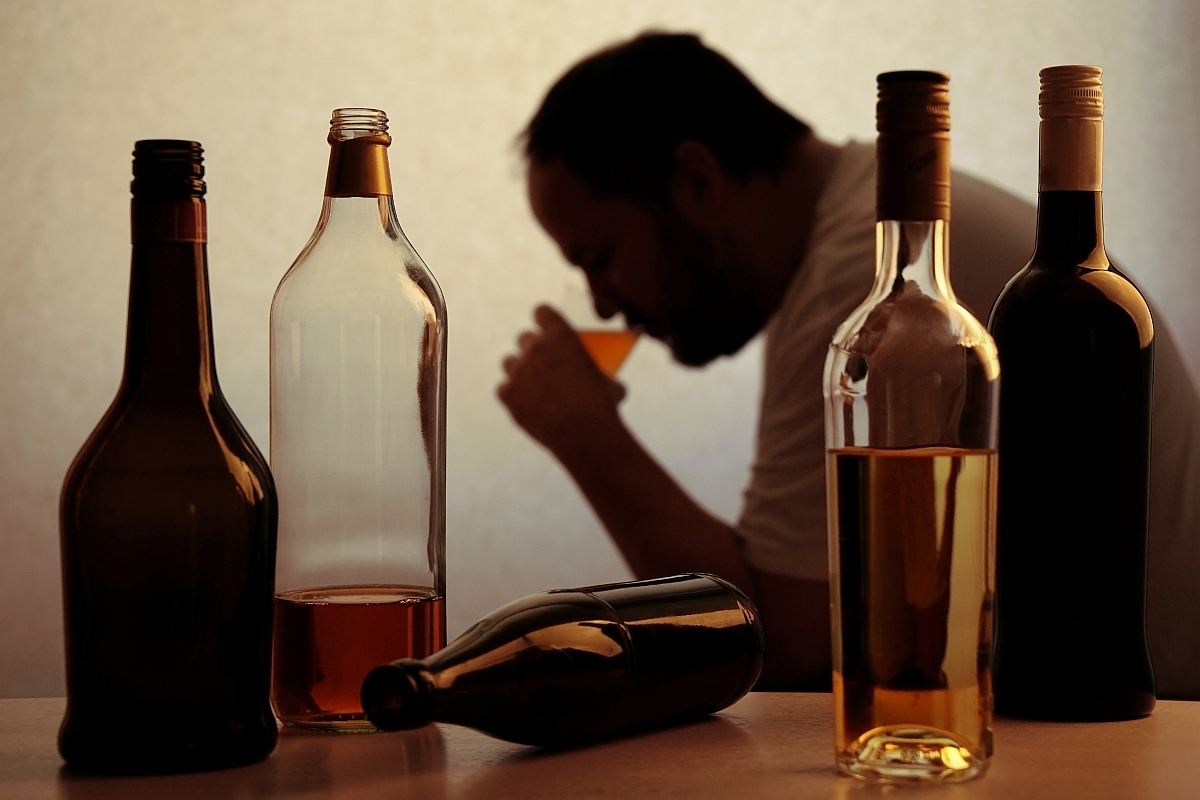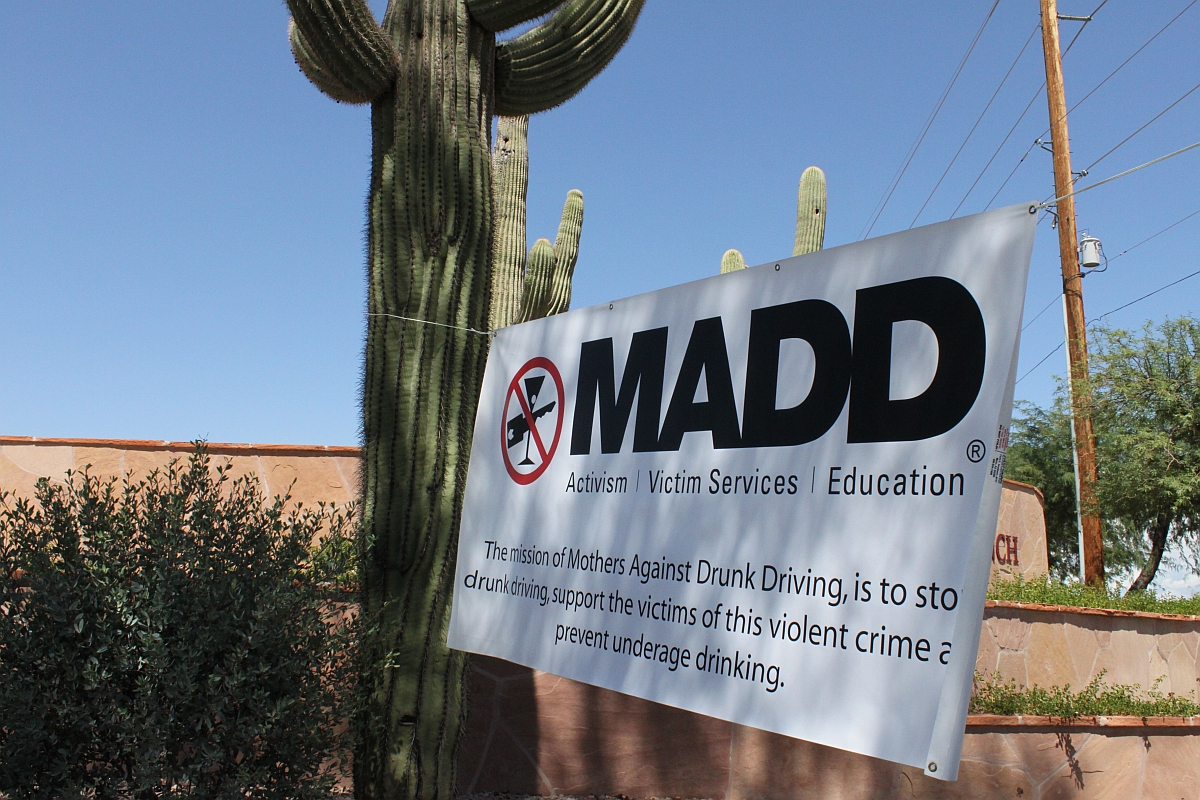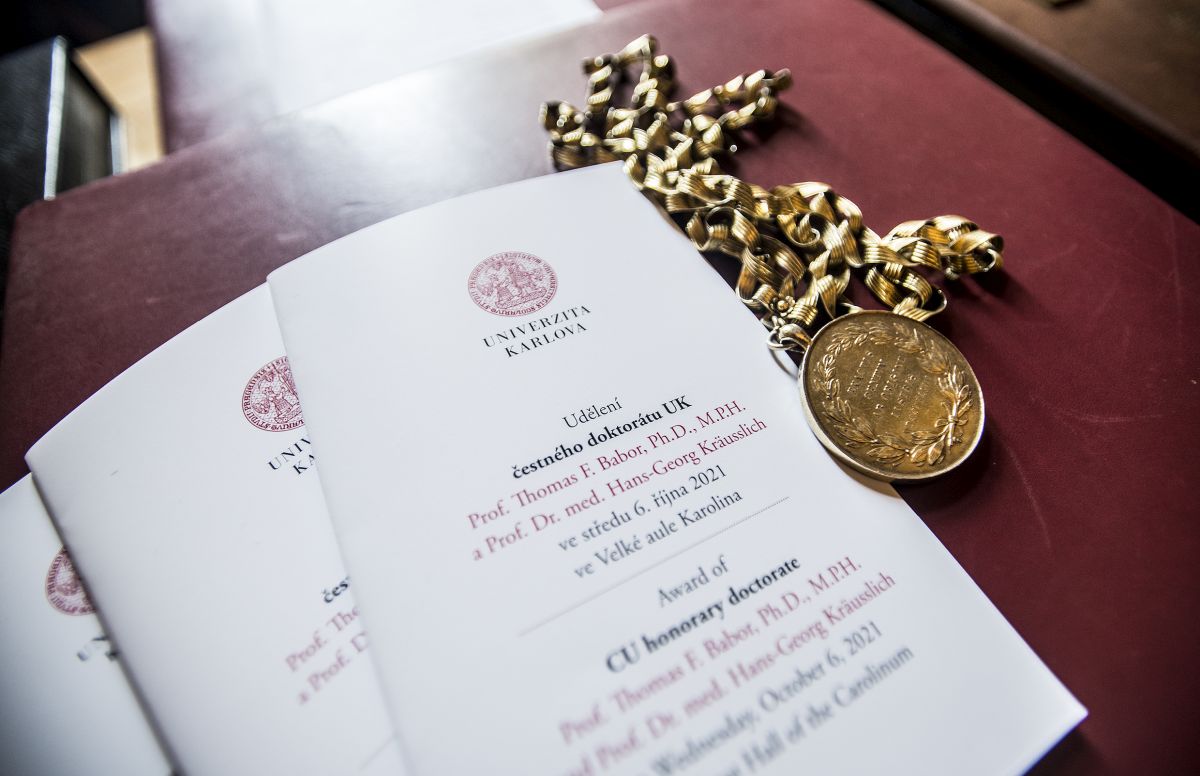Thomas F. Babor is a renowned researcher and professor of Public Health Studies at the University of Connecticut and author of more than 15 books and the editor of Publishing Addiction Science. In the late 1980s, Prof. Babor was one of the main scientists involved in the creation of AUDIT (an acronym he coined) – the international screening test for alcohol use which has had phenomenal success as an early warning system for growing dependency. This week Babor received an honorary degree from Charles University.
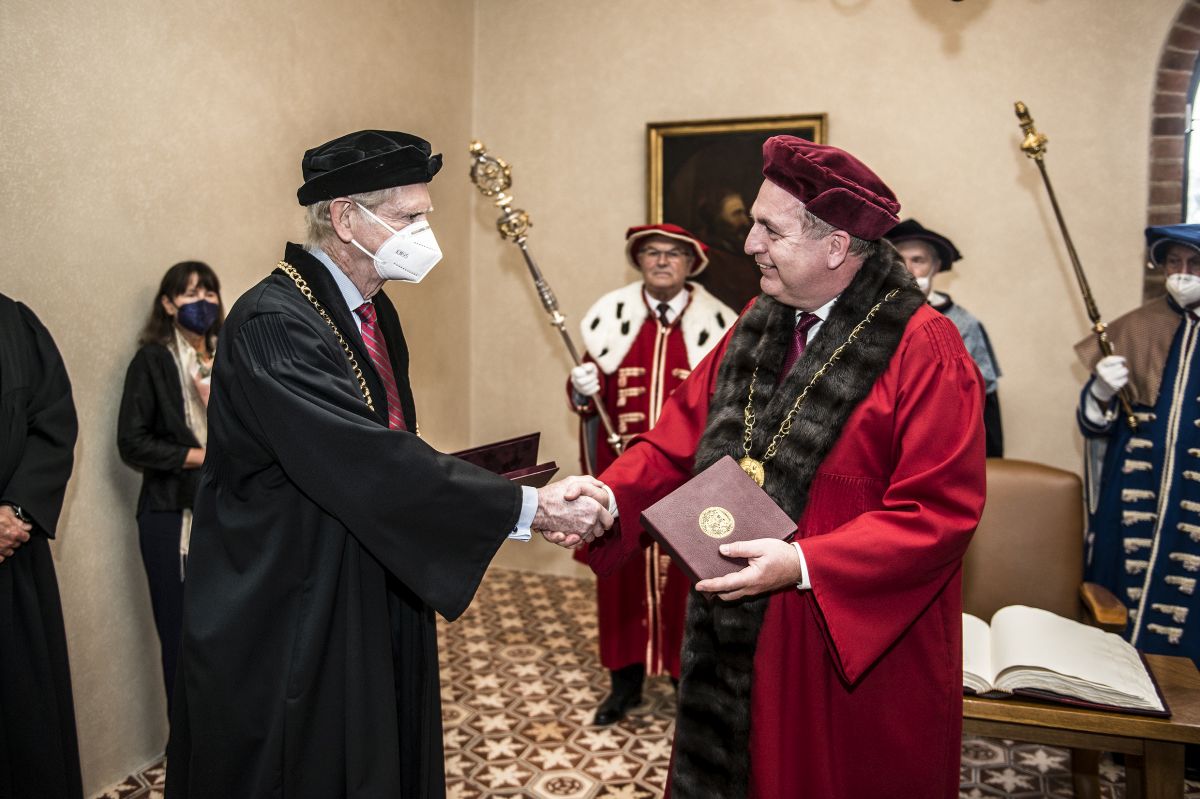
Professor Thomas F. Babor (left) receives congratulations from Charles University Rector Tomaš Zima at the Carolinum on October 6, 2021.
A lot of people by now have heard of or even taken AUDIT as an early screening system – it has been a phenomenal success around the world. How did it come together?
In the 1980s the World Health Organisation (WHO) began to be very interested in preventive medicine around alcohol and other drugs and they asked a group of scientists to put together screening questions that could be used to identify people not only with alcoholism or alcohol dependence but also people at risk of developing it so that health professionals could do an intervention before it got any worse. We developed the Alcohol Use Disorders Identification Test (AUDIT) with that dual purpose in mind.
Remarkably, because of the tremendous need not only to find alcoholics in medical settings and intervene with them, but also the need to identify people who were slipping into a pattern of heavy drinking, we had a tremendous response when WHO first published the test. They began to translate it into different languages and it provided a complement to other tests that solely focuses on the identification of severe alcoholism.
I read that it has been translated into 50 or more languages…
I’ve stopped counting! But yes, it has been translated and adapted to many different countries and cultures.
How has the test been tweaked since?
We developed it and tested it out in a 6-nation study and it was designed to be applicable across countries and cultures. Nevertheless, there has been a need to make adaptations, particularly since it asked about drinking in standard units, which vary from country to country.
As a tool it is one of the initial methods to determine whether someone has a drinking problem. How much has it helped uncover problems? Not only with alcohol abuse but related medical conditions?
The first three questions focus mainly on identification, asking about how often people drink, how much they drink on each occasion and how often they have six or more drinks, which is not only the threshold to produce intoxication but also the amount that puts them at risk of all kinds of other problems: accidents, injuries, and chronic illnesses. It has been very useful in finding people who don’t wake up in the morning with withdrawal symptoms but who are slipping into the pattern of regular, heavy drinking, which could be two or three drinks a day.
Even at those levels, we have good evidence that regular drinking is associated with hypertension and many other medical conditions. So we can identify the risk factor for conditions that are in development and that is very important.
As you say, there can be all kinds of related illnesses, from liver disease to different cancers and so on.
Exactly. There are about 200 different health conditions that are associated with heavy drinking.
Who takes the test? Because it seems that there is a segment of the population that would benefit but maybe cannot be persuaded.
The target group is anyone over the age of 16 or 18 because everyone is at risk of alcohol problems. Many people who use the AUDIT in medical settings [e.g. a doctor treating his or her patient] have reduced the test from the initial 10 to just the three main questions about the frequency and amount of alcohol consumption. The remaining questions ask about dependence symptoms and alcohol-related problems. If people answer the first three in a way that they are passing the threshold for risk, then you can ask the rest. So the target group for this test is anyone who comes in for a doctor’s appointment.

Signing the chronicle at Charles University on October 6, 2021.
I took the test myself to get a sense of the range and the threshold; one thing that is apparent is that as long as you are truthful, there is nowhere to hide. If someone does get a warning through their result is it a shock? Because I imagine many people, on some level, must “know” they have a problem.
If people are drinking at a level where they cannot control their drinking, they are at risk of losing their job, have had an accident or injury because of their drinking, they are likely to be aware they have a problem and the test confirms it and helps to motivate them to cut down or stop.
On the other hand, people who are at risk – drinking three or four drinks a day but who would never consider themselves alcoholics – those people are quite surprised when they are told they are drinking above the safe limit and that they need to cut back. So it’s mainly for those who are at risk, who think they are drinking as much as anybody else and think that it’s normal.
It was fascinating to read your article The Classification of Alcoholics Typology Theories from the 19th Century to the Present, including about the Jellinek era. Jellinek, you have said in interviews, was a big influence on your own work.
E. M. Jellinek was born in Brooklyn but his parents came from Central Europe, and he was a seminal thinker who is considered the founder of modern alcoholism studies. In the 1960s, he wrote a book called The Disease Concept of Alcoholism and he used as examples the types of alcoholism found in different parts of the world. In particular, he looked at French and German alcoholics – buveur d’habitude in French and stammtisch in German, designating people who lived in a culture of alcohol, drank every day, but didn’t consider themselves to be alcoholics.
In France, where I once conducted research on alcoholic patients, when I asked them if they drank alcohol they answered “No, all I do is drink wine.” They didn’t consider wine to be alcohol. They drank on average two or three litres every day and they become not only habituated but physically dependent. At that point such drinkers usually start to develop liver problems, psychological/psychiatric problems, cardiovascular diseases, and all of the associated illnesses.
That type of alcoholic was contrasted with the more blatant type of heavy, intense, drink-to-intoxication type of alcoholic, who would be periodically drunk for several days at a time. Patients with this more extreme form of frequent intoxication are called Gamma alcoholics. They often have psychiatric problems, have a quicker course and are more likely to have a genetic vulnerability. Whereas the “Delta” or cultural alcoholics – the ones who drink just because everyone else does – become gradually dependent over time.
Alcohol consumption, even frequent or heavy drinking, is a large part of the social fabric in the Czech Republic: it always strikes me that the descent may begin innocently enough, but the more someone falls, the more signs are available. Yet these are ignored even by close friends or relatives until it is a major problem. In a word, the scary thing is denial, the lie or lying that seems to be a core aspect of alcoholism.
Many of the people are in denial with regards to being labelled an alcoholic. If you ask them if their hands are shaking when they get up in the morning, or if they immediately have a drink to calm themselves, they won’t deny that. They will describe their symptoms and then it becomes a question of how you engage them in a motivational conversation that is going to lead them to admit they need to cut back or stop drinking. That particular type of Delta alcoholic often responds well to treatment.
What is your view on alcohol in general? We have various bans on soft drugs, stiff bans on hard drugs, yet alcohol is the one that has always been socially acceptable. I am not in any way against alcohol but it is the one which is accepted in so many situations that it seems to be the one were the risk is masked or underestimated.
Well, the control of alcohol consumption is a government function and it has been controlled since ancient times: the Egyptians put restrictions on serving beer in taverns. Prohibition in the US was another example of attempts to get the government involved in limiting the availability of alcohol. Experiments in alcohol control that have been conducted over centuries have now been investigated through policy research to find out which measures are capable of driving down alcohol dependence rates and alcohol-related accidents and injuries.
It’s important to note that alcohol control is a public health function but society often doesn’t want to take responsibility for it, even though one of the most effective interventions is making alcohol less affordable. If you use taxation to take away the cheap alcohol that alcoholics gravitate to, that is effective in driving down rates of alcohol problems and it also produces government revenues. Governments are ambivalent about alcohol, especially in countries where consumption is so ingrained. But eventually they come to the realisation that they have to do something about it, when – just like with Covid – the healthcare system becomes overwhelmed.
I didn’t grow up in the Czech Republic but in Canada and I still remember public campaigns then run by organisations like MADD (Mothers Against Drunk Driving) and maybe it is because I was a kid, but it was just drummed into us that some things just weren’t acceptable. Concentrated warnings about drinking and driving and the first graphic campaigns seemed to work. My question is, should there be more of this, for example, in Czech society? There have been intermittent campaigns but I don’t get the sense the need for awareness has been consistently incorporated at elementary schools, for example. Should there be more of that?
There are differences of opinion about how to reduce the rates of alcohol problems in society. The Czech Republic has work to do in order to reduce the average amount of consumption in the general population which will then produce benefits throughout society and in particular in the health care system. Education alone, which is often used as first response when there is a perception that there is too much drinking going on, is not the answer. It is not going to solve the problem alone. But when you combine that with advocacy groups, like MADD, or larger social movements like Temperance, where religious organisations encouraged people within their congregations and beyond to reduce the availability of alcohol, then you can begin to have an impact.
A third alternative is for governments to begin changing the support system that exists on a structural level to facilitate heavy drinking: low prices, easy availability and convenience, and frequent marketing. Sophisticated marketing like that found on Facebook, often targets young people. Higher alcohol taxes are a way of making the alcohol industry responsible for the debt that they are helping to accumulate in society. I think that the solution in modern societies such as the Czech Republic is for the government to realize that we can’t afford to have this much drinking going on because of its social and financial costs.

Professor Thomas Babor addresses esteemed guests and academics at the Honoris causa ceremony on October 6 at Charles University.
The numbers in the Czech Republic are really quite stunning: it has been estimated that up to 1.5 million people here are at risk of alcohol dependency and this is in a country of only around 10.5 million. It strikes me that it is a serious issue but not one that would come up in the weeks or months ahead of the national election. It must be a real burden on healthcare workers, not least because alcoholism is so difficult to beat. Even those who have successfully given up drinking, face an enormous task to remain sober and not “fall off the wagon”.
There has been progress made in the development of better interventions: the identification of alcohol problems before severe dependence develops is one solution. At least within the medical community, we have begun to change our attitudes about what this problem is: it is not just a “weak will” or selfishness or some sort of character flaw. It is actually a physical, psychological and behavioural disorder. When the symptoms of alcohol dependence develop in an individual, they can be a very powerful motivator for people to continue drinking no matter what happens to themselves or others. That puts additional responsibility on us as a medical community to find better interventions. We now have effective pharmacological interventions, psychosocial interventions, and what is probably even more effective, ways of changing the support network for a person with alcohol dependence in their social environment. Self-help organizations like Alcoholics Anonymous can not only help people to stop drinking but also to continue not drinking.
You were strongly involved in the development of the science and research Addictology Clinic in Prague; that must have been quite an experience.
More than 20 years ago, I met Charles University’s Professor Michal Miovský at an international meeting. I was impressed with his enthusiasm for publishing addiction science – it was an editors’ meeting actually – and I kept in contact with him. Being a Czech-American I was interested in the country and knew that it had a very serious alcohol problem. I observed with great interest the construction of an infrastructure at Charles University under his leadership, one that brought together social scientists, behavioural scientists, medical practitioners, nursing professionals – all of the professions that are needed to have a centre of excellence within a university.
What you need within a society to control alcohol problems is a group of scientists and experts who are able to work not only in the healthcare system but also with government officials to implement the best policies to limit alcohol consumption and at the same time conduct research that is going to advance the science. All of those elements have been put together over the years here at Charles University. The Czech Republic now is well-positioned, I believe, to be part of an international movement that is being led by the World Health Organisation to drive down the rates of alcohol problems globally.
As an advisor to WHO, it must be so rewarding when public policy changes are implemented based on data and the outcome of research…
Yes, it’s amazing to observe what happens when there is a deliberate attempt to implement evidence-based alcohol policy. One of the most striking examples of what occurred in France during the Phylloxera epidemic in the 19th century where a fungus attacked the root systems of the vineyards and destroyed the vineyards all over France. Alcohol consumption declined dramatically. So did hospital admissions for alcoholic psychosis and for liver cirrhosis. That is a good example of how changes in alcohol availability can induce changes in the number of the people who experience alcohol problems.
The more recent example is Russia between 1980 – 2020 where you had a series of ups and downs in the economy and also in regulations. During Gorbachev’s period consumption went down from a very high level because he imposed controls which included limiting price, availability, and making intoxication less appreciated within society as a “Russian tradition”. It went up under Boris Yeltsin and down again under Putin. These ups and downs are associated with dramatic changes not only in alcohol consumption but in life expectancy. The epidemiologists couldn’t figure out why life expectancy was so low in Russia prior to Gorbachev and then again under Yeltsin. Finally they had to admit after looking at the mortality data that it was due to changes in alcohol consumption. You could get a change in life expectancy of four or five years on average, particularly for males, in a heavy drinking country like Russia if you could cut alcohol consumption by one-third or more.
As you said, it requires not only very real measures but also an attitude shift which runs a little contrary to how drinking is often portrayed in popular culture and so on.
There is now a much greater interest by social scientists in looking at how people learn to drink, and the concepts that they have of what it means to drink. Traditionally, heavy drinking in many countries is considered a part of the culture, although we know when there is a powerful industry producing wine, beer or distilled spirts that those industries promote ideas that glorify drinking as part of the national culture. Now we have much greater evidence of how these concepts within society are generated and also can track it back, now, to the powerful influence that the alcoholic beverage industry has had on modern society.
They have at their disposal enormous budgets, which go to marketing. It shows people enjoying themselves, without problems, having fun. Kids learn this from the social media and from film and TV where actors are paid to drink onscreen. This is how people learn that there is a culture of heavy drinking.

Advertising often shows alcohol consumption in the best possible light. It's always fun & games. The reality can be different (illustrative example).
And here I thought the spirits industry was since self-policing and self-regulating or tempering their message. I remember glossy magazine ads from the early and mid-1980s and yes, they looked like fabulous lifestyles. Parties at beachfront cottages, romance in the setting sun, and whether they influenced me or not, I certainly remember the message. What’s more, the message remains the same, but now spreads via the internet. You are the editor of The Journal of Studies of Alcohol and Drugs and just now there is a feature story up about how Tik Tok videos are presenting a new danger and ringing alarm bells.
Certainly alarm bells is a good analogy. The use of social media is something that people involved in the prevention of alcohol problems in young people were unprepared for. They knew that advertising could influence kids but now there is a new way of getting people to buy alcohol, which is to take user-generated content and distribute it to encourage people to drink more. The marketers have realised that people are not only influenced by emotional messages but also by messages from people like themselves.
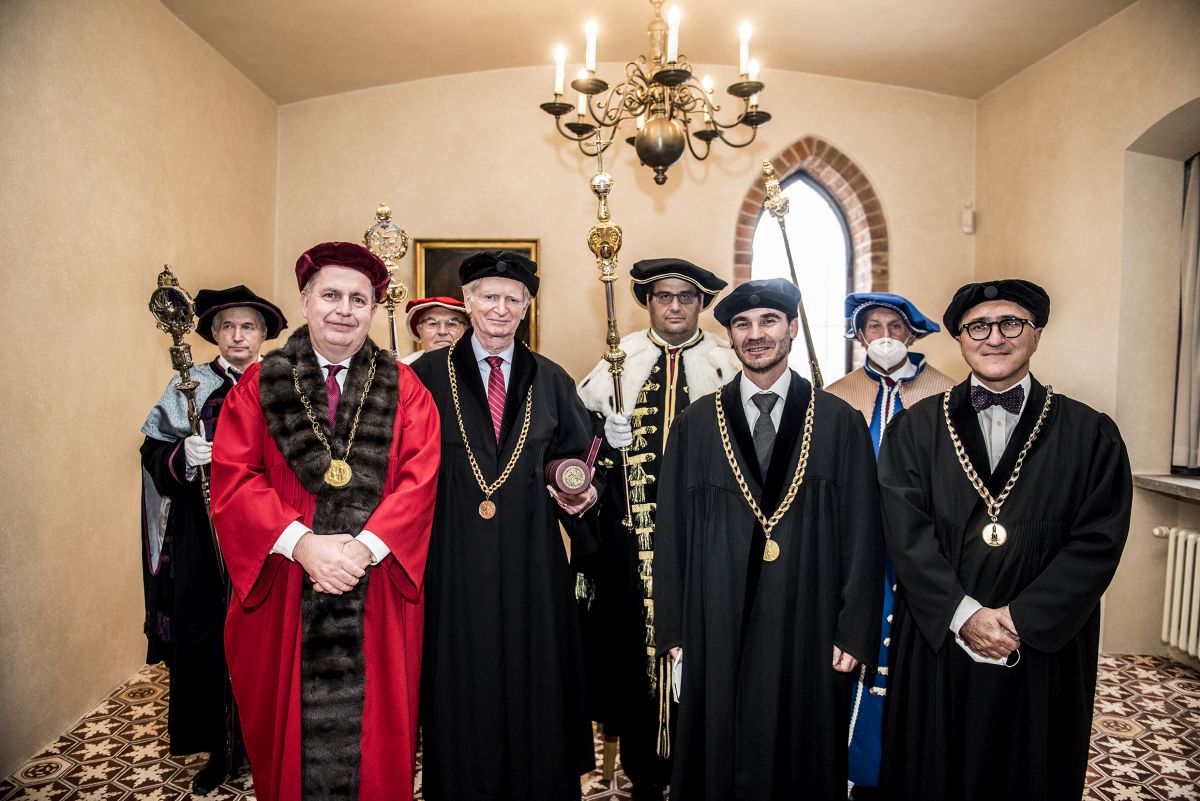
The rector of Charles University Tomáš Zima (in red) and fellow colleagues pose with Professor Thomas Babor (to the right of the rector).
By encouraging people to like and share things that they see on the media, in particular kids’ videos of themselves doing outrageous things, the industry creates brand loyalty in the product. The industry claims that they are regulating their marketing and acting responsibly. But the data that comes from public health surveillance suggest that alcohol marketing to kids is deliberate and the industry’s self-regulating approach has been a failure. The industry has complete freedom to invade even countries like France which has relatively strict regulations against the marketing of alcohol, but they can get around marketing bans through the use of social media. That is very troubling.
Are there any answers? The regulation of social media is a huge question mark in and of itself…
Well, it’s a question mark but we are beginning to figure out the answer. On the one hand, the alcohol industry is becoming globalised so we have big transnational corporations that control most of the traditional brands. Budweiser is an American beer with a Czech name but it has become the largest beer producer in the world by buying up hundreds of other brands worldwide. So our response needs to be on a global level because they can use their profits generated by economies of scale to produce cheaper alcohol and to use sophisticated marketing to influence young people to begin drinking, particularly in parts of the world that have low consumption levels like Asia, Africa, Latin America. When that happens we need a global response, something like the United Nations’ Framework Convention on Tobacco Control which has been successful in beginning to rein in the ability of these big transnational tobacco companies to addict millions of people around the world.
You were born in New York but your grandparents were from Czechoslovakia so you have Czech roots and you have been coming here for years.
I first visited in 1981 and it was fascinating to follow the changes that occurred in the Czech lands during the ‘90s in particular. Working with the Addictology Department has been a great experience, allowing me to become more familiar with Czech culture and Czech society. I am proud to be a Czech-American.
You are also here for a very special reason, to be honoured by Charles University for your work, receiving an honorary degree. Congratulations! Some professors get a little nervous ahead of the ceremony, any nerves?
I feel more humbled than nervous. It’s a great honour to be recognised by this particular university for accomplishments on an international level that deal with alcohol studies. I am very proud to have this particular honour bestowed on me – it is one of the great experiences of my life.
| Professor Thomas F. Babor, Dr.h.c. |
| Thomas F. Babor, PhD, MPH, is a Professor Emeritus and former Chairman in the Department of Public Health Sciences, University of Connecticut School of Medicine, USA. His academic training is in social psychology, addiction science and psychiatric epidemiology. His research interests include screening, diagnosis, early intervention, and treatment evaluation, as well as alcohol and drug policy. He has worked with the World Health Organization on the development of Alcohol Use Disorders Identification Test (AUDIT) and the Alcohol, Substance Involvement Screening Test (ASSIST). He is Editor-in-Chief of the Journal of Studies on Alcohol and Drugs, and the co-author of Alcohol: No Ordinary Commodity (2010) and Drug Policy and the Public Good. (2018). He is currently the Director of the Graduate Certificate Program in Addiction Science, which provides advanced training to graduate students and post-doctoral fellows in alcohol and drug research. |



